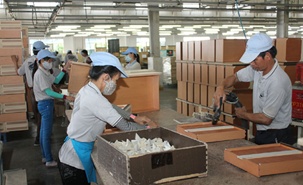Labour productivity lags behind region
 |
| Workers produce wooden wardrobes in southern Binh Duong Province. Viet Nam's labour productivity is said to be among the lowest in the Asia-pacific region. VNA/VNS Photo Quach Lam |
The International Labour Organisation recently said that Viet Nam's labour productivity is among the lowest in the Asia-Pacific region.
Dr Ho Duc Hung from HCM City's University of Economics said Viet Nam's labour productivity was 10 times lower than Indonesia's, 20 times lower than Malaysia's and 30 times lower than Thailand's, according to the Ministry of Labour, Invalids and Social Affairs' website.
He said it would be an illusion to think of Viet Nam's low labour cost as an advantage, because labour productivity was a bigger contributor to enterprise profits.
In a workshop on minimum wage held in early June, Vi Thi Hong Minh, deputy director of the Employers' Bureau at the Viet Nam Chamber of Commerce and Industry said that Viet Nam's labour productivity was still too low to keep pace with the demand for salary increases.
Minh's report showed that while company turnover per worker had increased by more than 2.6 per cent in 2012, the wage range had increased significantly faster at 15.3 per cent.
In mid-April, at another seminar held by Viet Nam's Central Economic Commission in mid-April, Professor Kenichi Ohno from Japan's National Graduate Institute for Policy Studies (GRIPS) also said that in Viet Nam, wages had increased faster than labour productivity, implying that salary increases did not show better performance.
He cited that during 2009-12, Viet Nam saw a wage increase of 25.9 per cent but its labour productity only increased by 3.2 per cent. During the same period, Japan saw wages increase by 9.8 per cent and an increase of 10.1 per cent in labour productivity.
According to Dr Tran Chi Thien, director of the Viet Nam Institute of Economics under Viet Nam Academy of Social Sciences, there were plenty of reasons behind Viet Nam's low labour productivity.
He said Vietnamese workers often had low skills, usually engaging in manual labour such as assembling rather than high-skilled work.
Outdated technology far behind the world's latest advances was also a factor in the low labour productivity.
"The world's technology has changed constantly within the past 3-4 years but two thirds of Vietnamese companies still use outdated technologies from 20 years ago."
Thien attributed such lack of investment to capital limitations that many enterprises were facing.
Ohno from Japan's GRIPS said Viet Nam needed to give more priority to policies that would increase labour productivity.
He added that the Government needed to request regular data on labour productivity progress and wage increases to develop effective policy responses.
He said the Government and enterprises also needed to work together to target improvements in labour productivity and make it a top priority, adding that it should be at the top of the country's national working agenda towards 2020.
According to the World Economic Forum's Global Competitiveness Index 2013-14, Viet Nam ranked 70th out of 148 countries globally.
It ranked behind the Philippines (59th), Indonesia (38th), Thailand (37th) and Malaysia (33th), but was still ahead of Laos (81st),Cambodia (88th) and Myanmar (139th).
The World Economic Forum's report for 2013-14 also highlighted that during the past few years, Viet Nam had lost ground in several areas of the Global Competitiveness Index, including labour market efficiency (56th) and technological readiness (102nd).
The report also said that despite some encouraging developments in the economy and curbing inflation, the foundation of Viet Nam's economy and prosperity remained fragile.
What the stars mean:
★ Poor ★ ★ Promising ★★★ Good ★★★★ Very good ★★★★★ Exceptional
Latest News
More News
- Protect what’s next: towards a future free from meningococcal group B disease (December 05, 2025 | 18:00)
- New ILO report offers policy recommendations for disability inclusion (December 04, 2025 | 15:18)
- Maternal job loss may affect children’s mental health, research shows (December 03, 2025 | 19:11)
- Women lead Vietnam’s shift to climate-resilient agriculture (December 03, 2025 | 19:10)
- Experts highlight unpaid care work as key barrier to gender equality (December 03, 2025 | 15:15)
- Opportunities and inequalities for women workers in Vietnam's garment industry (December 03, 2025 | 09:00)
- Vietjet flights carry love to devastated central region (November 28, 2025 | 11:35)
- New initiative to boost the fight against domestic violence (November 26, 2025 | 10:00)
- South Korea funds IOM relief for Vietnam’s typhoon-affected communities (November 24, 2025 | 15:33)
- AI and human-centred values set to shape the future of HR in Vietnam (November 21, 2025 | 18:04)

















 Mobile Version
Mobile Version